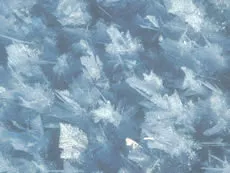Cryosphere glossary
crystals of ice that form when water vapor becomes a solid (bypassing the liquid phase) and deposits itself on the sea ice surface; frost flowers roughen the surface and dramatically affect its electromagnetic signal.
Image

Close-up view of frost flowers.
Don Perovich, U.S. Army Cold Regions Research and Engineering Laboratory
the upward or outward movement of the ground surface (or objects on, or in, the ground) caused by the formation of ice in the soil.
the difference between the elevations of the ground surface before and after the occurrence of frost heave.
cumulative upward displacement of objects embedded in the ground, caused by frost action.
any mound-shaped landform produced by ground freezing combined with accumulation of ground ice due to groundwater movement or the migration of soil moisture.
effects of frost action on earth materials and on structures placed in or on the ground.
the highest temperature at which atmospheric moisture will sublimate in the form of hoarfrost on a cooled surface; it is analogous to the dew point.
the mechanical disintegration of rock by the pressure of water freezing in pores and along grain boundaries.
fog-like clouds, due to the contact of cold air with relatively warm water, which appear over newly-formed leads, or leeward of the ice edge, and which may persist while new ice is forming.
the differential movement of soil particles of different sizes as a result of frost action.
the disintegration and break-up of soil or rock by the combined action of frost shattering, frost wedging and hydration shattering.
the mechanical disintegration, splitting or break-up of rock by the pressure of water freezing in cracks, crevices, pores, joints or bedding planes.
ground (soil or rock) in which little or no segregated ice forms during seasonal freezing.
ground (soil or rock) in which segregated ice will form (causing frost heave) under the required conditions of moisture supply and temperature.
soil in which segregated ice will form (causing frost heave) under the required conditions of moisture supply and temperature.
the zone in a freezing, frost-susceptible soil between the warmest isotherm at which ice exists in pores and the isotherm at which the warmest ice lens is growing.
the phase transition of a substance passing from the solid to the liquid state, melting; in meteorology, fusion is understood to refer to the melting of ice, which, if the ice is pure and subjected to one standard atmosphere of pressure, takes place at the ice point of 0 degrees Celsius (32 degrees Fahrenheit).